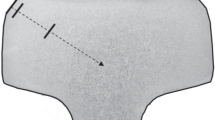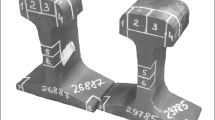Abstract
By using modern physical-materials science methods, the roll surface of structural-phase states and mechanical properties has been analyzed at a distance ranging from 0 to 22 mm with respect to the central axis and to the fillet of differentially-quenched DT 350 grade 100-meter-long rails. These rails have been manufactured at Evraz United West Siberian Metallurgical Plant after long-term operation on an experimental test ring (passed gross tonnage amounting to 1411 million tons). According to chemical composition, the rail metal satisfies the requirements of TU (Engineering Specifications) 0921-276–01124323–2012 for steel E76HF grade steel. The impact strength and hardness on the head’s roll surface and throughout the cross section meet the TU (Engineering Specifications) requirements. The microstructure of the rail metal is represented by finely dispersed lamellar pearlite—1.5 points of scale No. 7 according to GOST (State Standard) 8233—with inclusions of excess ferrite along the grain boundaries. The interlamellar distance in the railhead ranges from 0.10 to 0.15 μm. The long-term operation of the rails is accompanied by the formation of a gradient structure presented by a regular change in hardness, microhardness, and impact strength throughout the railhead section. The microhardness at a depth of 2 mm counted from the roll surface amounts to 1481–1486 MPa. At a depth of 10 mm, the microhardness decreases to 1210–1385 MPa, which is caused by an increase in the interlamellar distance and by a decrease in the level of metal cold-work strengthening in the course of long-term operation. It has been suggested that this could be caused by an increase in the interlamellar distance and by a decrease in the level of cold-work strengthening in the course of long-term operation.




Similar content being viewed by others
REFERENCES
Gromov, V.E., Yuriev, A.B., Morozov, K.V., and Ivanov, Y.F., Microstructure of Quenched Rails, Cambridge: Cambridge Int. Sci., 2016.
Shur, E.A., Povrezhdeniya rel’sov (Rail Damage), Moscow: Intekst, 2012.
Ivanisenko, Yu. and Fecht, H.J., Microstructure modification in the surface layers of railway rails and wheels, Steel Tech., 2008, vol. 3, no. 1, pp. 19–23.
Ivanisenko, Yu., MacLaren, I., Souvage, X., Valiev, R.Z., and Fecht, H.J., Shear-induced α → γ transformation in nanoscale Fe–C composite, Acta Mater., 2006, vol. 54, pp. 1659–1669.
Ning, J.-L., Courtois-Manara, E., Kurmanaeva, L., Ganeev, A.V., Valiev, R.Z., Kübel, C., and Ivanisenko, Yu., Tensile properties and work hardening behaviors of ultrafine grained carbon steel and pure iron processed by warm high pressure torsion, Mater. Sci. Eng., A, 2013, vol. 581, pp. 8–15.
Gavriljuk, V.G., Decomposition of cementite in pearlitic steel due to plastic deformation, Mater. Sci. Eng., A, 2003, vol. 345, nos. 1–2, pp. 81–89.
Li, Y.J., Chai, P., Bochers, C., Westerkamp, S., Goto, S., Raabe, D., and Kirchheim, R., Atomic-scale mechanisms of deformation-induced cementite decomposition in pearlite, Acta Mater., 2011, vol. 59, no. 10, pp. 3965–3977.
Gavriljuk, V.G., Effect of interlamellar spacing on cementite dissolution during wire drawing of pearlitic steel wires, Scr. Mater., 2001, vol. 45, no. 12, pp. 1469–1472.
Sheinman, E., Wear of rails. A review of the American press, J. Frict. Wear, 2012, vol. 33, no. 4, pp. 308–314.
Anisimov, P.S., Influence of design and parameters of trolleys on wear of wheels and rails, Zheleznodorozhn. Transp., 1999, no. 6, pp. 38–42.
Gromov, V.E., Yuriev, A.A., Ivanov, Yu.F., et al., Defect substructure change in 100-m differentially hardened rails in long-term operation, Mater. Lett., 2017, vol. 209, pp. 224–227.
Gromov, V.E., Yuriev, A.A., Peregudov, O.A., et al., Physical nature of structure and properties degradation of rail surface after long term operation, AIP Conf. Proc., 2017, vol. 1909, p. 020066.
Influence of rail wear and lubrication on interaction of vehicle-rail, Zhelezn. Dorogi Mira, 2003, no. 9, pp. 66–70.
Ermakov, V.M., Analysis of road performance in order to reduce “wheel-rail wear,” Zheleznodorozhn. Transp., 2005, no. 7, pp. 58–64.
Lysyuk, V.S., The reasons of cars coming-off and rail wear in curves, Zheleznodorozhn. Transp., 2004, no. 11, pp. 50–52.
Shapovalov, V.V., Shcherbak, P.N., Maiba, I.A., and Kostygov, V.T., Methods of elimination of wheels and rails wear, Zheleznodorozhn. Transp., 2004, no. 3, pp. 111–115.
Grebe, M., Ways to reduce wheel and rail wear, Zhelezn. Dorogi Mira, 2002, no. 4, pp. 65–72.
Zhong, W., Hu, J.J., Shen, P. Wang, C.Y., and Lius, Q.Y., Experimental investigation between rolling contact fatigue and wear of high-speed and heavy-haul railway and selection of rail material, Wear, 2011, vol. 271, nos. 9–10, pp. 2485–2493.
Tyfour, W.R., Beynon, J.H., and Kapoor, A., The steady state wear behavior of pearlitic rail steel under dry rolling-sliding contact conditions, Wear, 1995, vol. 180, nos. 1–2, pp. 79–89.
Singh, U.P. and Singh, R., Wear investigation of wheel and rail steels under conditions of sliding and rolling-sliding contact with particular regard to microstructural parameters, Wear, 1993, vol. 170, no. 1, pp. 93–99.
Defekty rel’sov. Klassifikatsiya, katalog i parametry defektnykh i ostrodefektnykh rel’sov (Rail Defects: Classification, Catalog and Parameters of Cropped and Defective Rails), Moscow: Ross. Zhelezn. Dorogi, 2014.
ACKNOWLEDGMENTS
The authors are grateful to A.M. Yunusov for his help in performing the experiments and discussing the results.
Funding
This work was financially supported by the Russian Foundation for Basic Research (project no. 19-32-60001).
Author information
Authors and Affiliations
Corresponding authors
Additional information
Translated by O. Polyakov
About this article
Cite this article
Kormyshev, V.E., Polevoi, E.V., Yur’ev, A.A. et al. The Structural Formation in Differentially-Hardened 100-Meter-Long Rails during Long-Term Operation. Steel Transl. 50, 77–83 (2020). https://doi.org/10.3103/S0967091220020047
Received:
Revised:
Accepted:
Published:
Issue Date:
DOI: https://doi.org/10.3103/S0967091220020047




